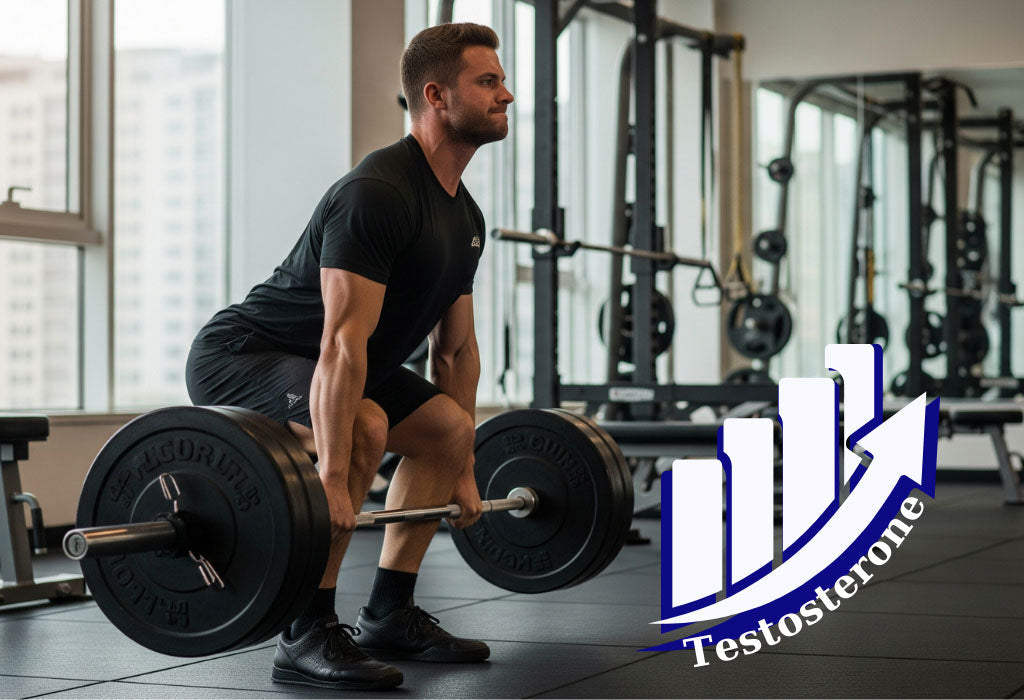
What Workouts Increase Testosterone?
Everyone knows that exercise offers great health benefits, including boosting testosterone. However, only certain types of training truly raise it. Knowing which specific workouts increase testosterone can help you create a more effective and time-efficient workout plan.
Before exploring further, please read the disclaimer located at the end of this webpage.
Key Takeaways
- Exercise helps increase testosterone, with HIIT and resistance training being the most effective.
- Long-term training can slow age-related testosterone decline in men.
- Cardio does not raise testosterone in men and may even lower it; HIIT may reduce basal testosterone in women.
- A healthy lifestyle with good sleep, avoiding alcohol and toxins, plus a consistent testosterone-boosting workout plan supports natural testosterone levels.
Can Workouts Increase Testosterone?
Workouts can boost testosterone, but not all do.
Effectiveness depends on workout type, intensity, duration, age and individual health. Some testosterone boosting workouts work well, while others have little or no effect.
Recent Studies on Exercise and Testosterone Increase
The rise in testosterone from exercise is linked to improved insulin sensitivity, reduced inflammation and lower aromatase activity (the enzyme converting testosterone to estrogen in fat tissue). Exercise also enhances muscle strength and performance, further supporting testosterone production and its anabolic effects [5, 9].
Many studies have demonstrated a positive link between exercise and increased testosterone:
Resistance Training and Aerobic
Studies show these workouts to increase testosterone by reducing fat mass and positively regulating hormones. Weight loss through exercise combined with diet changes is also associated with healthier testosterone production, especially in overweight or obese individuals with metabolic issues [5].
High-Intensity Interval Training (HIIT)
HIIT is an effective workout that supports testosterone, producing acute rises in testosterone while lowering cortisol. Research shows HIIT improves free testosterone in older men and increases muscle strength [3, 6].
Aerobic in Obesity/Diabetes
Systematic reviews indicate aerobic workouts can boost testosterone in obese or type 2 diabetic individuals, mainly through fat loss and better metabolic health (Healy et al., 2024).
Lifelong Endurance Training
Sustained endurance training helps middle-aged men maintain higher testosterone, lower body fat and improved anti-inflammatory markers, therefore slowing age-related testosterone decline [8].
Workouts That Increase Testosterone
Here are 2 testosterone boosting workouts that you should try:
HIIT
HIIT helps increase free testosterone, improve cardiovascular health and burn fat [1,2,3].
This type of workout is one of the most effective to boost testosterone, especially free testosterone in middle-aged and older men. An 8-week testosterone workout plan with HIIT helps regulate the testosterone-cortisol balance, supporting strength and fitness in men aged 35-40.
HIIT also improves cardiovascular endurance, vascular function, lowers blood pressure and reduces risk factors such as waist-to-hip ratio (WHR). These effects are comparable or superior to moderate-intensity continuous training (MICT).
Since low muscle mass and high body fat reduce testosterone, HIIT serves as a testosterone workout that supports testosterone by increasing lean muscle and reducing fat.
Research showed that 90-second treadmill sprints alternated with 90-second recovery significantly raised free testosterone (Hackney et al., 2012).
Resistance Training

Immediate Testosterone Increase:
Compound strength exercises such as squats and deadlifts immediately raise circulating testosterone levels, especially when performed with heavy loads and sufficient intensity.
Free-weight training stimulates greater testosterone production than machine-based due to higher muscle activation and stabilization demands (Turgut et al., 2021).
Long-Term Testosterone Production:
Lifting heavy weights with low to moderate repetitions not only triggers acute spikes in testosterone but also promotes long-term adaptations, raising baseline testosterone levels. This hormonal increase supports recovery, muscle growth, and overall anabolic function [10].
Improved Muscle Mass and Metabolism:
Resistance training develops lean muscle mass, which boosts metabolic rate, improves insulin sensitivity, and reduces aromatase activity – the enzyme converts testosterone to estrogen.
Testosterone, as a key anabolic hormone, stimulates muscle protein synthesis, reduces protein breakdown, promotes muscle growth and strength. Increased muscle mass further supports testosterone maintenance through higher metabolic demand [11].
Enhanced Musculoskeletal Strength and Endurance:
Regular resistance training improves muscular strength, joint stability, and endurance. Better physical fitness encourages consistent activity and supports sustained testosterone production over time.
Which Workouts Do Not Boost Testosterone?
As mentioned, not all physical activities help increase testosterone. If your goal is to boost testosterone, here are the workouts to avoid or limit:
HIIT in Women
HIIT generally raises estrogen but significantly lowers basal testosterone in women, especially with long-term training. This can be beneficial in cases of elevated testosterone (such as PCOS), supporting hormonal balance and reproductive health [12].
However, testosterone fluctuations are also influenced by the menstrual cycle. Therefore, hormonal status should be considered when applying HIIT for women.

Cardio
Running, hiking, swimming and cycling usually don’t raise testosterone long term. They support health and weight control but may temporarily lower testosterone due to higher cortisol.
Besides, low-intensity workouts like yoga or pilates also don’t significantly boost testosterone, though they help reduce stress and improve overall balance.
Ways to Help Boost Testosterone

Natural ways to boost testosterone besides proper exercise:
- Maintain a healthy weight: Reducing body fat, especially around the abdomen, helps support healthy testosterone levels.
- Balanced diet: Including protein (lean meat, fish, eggs), zinc (oysters, beef), magnesium (spinach, nuts) and vitamin D in meals.
- Helpful foods: Onions, garlic, pomegranate, healthy fats from olive oil, avocado and nuts.
- Limit alcohol: Excess alcohol intake lowers testosterone and raises estrogen, harming reproductive health and muscle.
- Avoid hormone disruptors: Chemicals like BPA in plastics interfere with testosterone production. Use BPA-free containers and reduce toxin exposure.
- Sleep well & manage stress: This helps lower cortisol, maintain healthy testosterone levels.
Conclusion
In short, HIIT and strength-endurance training can support testosterone both in the short term and long term, while improving muscle strength, physique and metabolism.
Depending on gender, training goals and health status, certain workouts may be prioritized or limited. Moreover, beyond working-out, adopting a healthy lifestyle is essential for achieving balanced and long-term benefits.
Testimonial Disclaimer
*The testimonials presented on this website are provided by individuals based on their personal experiences with our products. These testimonials represent individual opinions and experiences, which may not be typical or applicable to all users of our products. Results may vary depending on a variety of factors, including individual health, lifestyle, and adherence to product usage instructions.References
- [1] Tadeusz Ambroży, Rydzik, Ł., Zbigniew Obmiński, Wiesław Błach, Serafin, N., Blanka Błach, Jarosław Jaszczur-Nowicki, & Ozimek, M. (2021). The Effect of High-Intensity Interval Training Periods on Morning Serum Testosterone and Cortisol Levels and Physical Fitness in Men Aged 35–40 Years. Journal of Clinical Medicine, 10(10), 2143–2143. https://doi.org/10.3390/jcm10102143
- [2] Hayes, L. D., Herbert, P., Sculthorpe, N. F., & Grace, F. M. (2017). Exercise training improves free testosterone in lifelong sedentary aging men. Endocrine Connections, 6(5), 306–310. https://doi.org/10.1530/ec-17-0082
- [3] Herbert, P., Hayes, L., Sculthorpe, N., & Grace, F. (2017). HIIT produces increases in muscle power and free testosterone in male masters athletes. Endocrine Connections, 6(7), 430–436. https://doi.org/10.1530/ec-17-0159
- [4] Hackney, A. C., Hosick, K. P., Myer, A., Rubin, D. A., & Battaglini, C. L. (2012). Testosterone responses to intensive interval versus steady-state endurance exercise. Journal of Endocrinological Investigation, 35(11), 947–950. https://doi.org/10.1007/bf03346740
- [5] Okobi, O. E., Khoury, P., De la Vega, R. J., Figueroa, R. S., Desai, D., Mangiliman, B. D. A., Vera Colon, O. L., Urruela-Barrios, R. J., Abdussalam, A. K., Diaz-Miret, M., & Hernandez Borges, S. (2024). Impact of Weight Loss on Testosterone Levels: A Review of BMI and Testosterone. Cureus. https://doi.org/10.7759/cureus.76139
- [6] Dote‐Montero, M., Carneiro‐Barrera, A., Martinez‐Vizcaino, V., Ruiz, J. R., & Amaro‐Gahete, F. J. (2021). Acute effect of HIIT on testosterone and cortisol levels in healthy individuals: A systematic review and meta‐analysis. Scandinavian Journal of Medicine & Science in Sports, 31(9). https://doi.org/10.1111/sms.13999
- [7] Healy, R., Patten, R., Bauer, C., Woessner, M. N., Bourke, M., Grossmann, M., & Levinger, I. (2024). The Effects of Aerobic Exercise Training on Testosterone Concentration in Individuals Who are Obese or Have Type 2 Diabetes: A Systematic Review and Meta-Analysis. Sports Medicine - Open, 10(1). https://doi.org/10.1186/s40798-024-00781-x
- [8] Gutierrez, S. D., Samuel, Barbosa, L. P., Santos, P. A., Maciel, L. A., Lopes, P., Rosa, S., Alves, L., Lewis, J. E., & Simões, H. G. (2021). Is lifelong endurance training associated with maintaining levels of testosterone, interleukin-10, and body fat in middle-aged males? Journal of Clinical and Translational Research, 7(4), 450. https://pmc.ncbi.nlm.nih.gov/articles/PMC8520705/
- [9] Zhang, L., Lang, H., Ran, L., Tian, G., Shen, H., Zhu, J., Zhang, Q., Yi, L., & Mi, M. (2022). Long-term high loading intensity of aerobic exercise improves skeletal muscle performance via the gut microbiota-testosterone axis. Frontiers in Microbiology, 13. https://doi.org/10.3389/fmicb.2022.1049469
- [10] Turgut, A., Varol, S., Yazıcı, A., & Günay, M. (2021). The effect of resistance exercises on testosterone. The Journal of Eurasia Sport Sciences and Medicine, 3(1), 1–10. https://dergipark.org.tr/en/download/article-file/1669373
- [11] Vingren, J. L., Kraemer, W. J., Ratamess, N. A., Anderson, J. M., Volek, J. S., & Maresh, C. M. (2010). Testosterone Physiology in Resistance Exercise and Training. Sports Medicine, 40(12), 1037–1053. https://doi.org/10.2165/11536910-000000000-00000
- [12] Ramadan, W., Xirouchaki, C. E., & Abdel-Hady El-Gilany. (2025). The Comparative Effects of High-Intensity Interval Training and Traditional Resistance Training on Hormonal Responses in Young Women: A 10-Week Intervention Study. Sports, 13(3), 67–67. https://doi.org/10.3390/sports13030067
Author

Product Disclaimer
Including an ingredient or study does not evaluate, endorse, or recommend any Vinatura product or any third-party product. Some ingredients discussed may not be used in any Vinatura product.
The content of the articles has not been evaluated by the Food and Drug Administration (FDA) and is not intended to promote or endorse any specific product. Any products sold on this website are not intended to diagnose, treat, cure, or prevent any disease.
Opinions and Endorsements
Any claims, statements, or opinions expressed in the articles are those of the author(s) and do not necessarily reflect the views or opinions of the manufacturers of the dietary supplement products. The products sold on this website are separate from the content of the articles and are not directly endorsed or associated with the information presented here.
Liability Disclaimer
The author(s) of the articles, website, and manufacturers of the dietary supplement products do not assume any liability for any potential consequences arising from the use of the information provided in the articles. Ingredient effects, dosages, and safety vary by individual, formulation, and context; some ingredients interact with medications or may be unsuitable during pregnancy or lactation. It is recommended that individuals consult with a qualified healthcare professional before making any dietary or lifestyle changes, including the use of dietary supplements.
Product Usage
Please refer to the product labels and packaging for specific usage instructions and guidelines for the dietary supplement products sold on this website.
Customer Support
For any concerns or questions regarding the dietary supplement products, please contact our customer support team, who will be more than happy to assist you.





Leave a Comment
Be the first to comment.
What do you think?